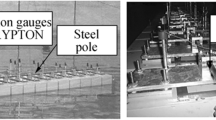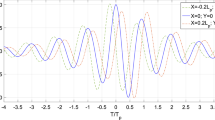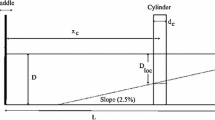Abstract
This paper investigates the interaction between large waves and floating offshore structures. Here, the fluid–structure interaction is considered using the weakly compressible smoothed particle hydrodynamics (SPH) method. To ensure the applicability of this method, we validate its prediction for fluid forces and rigid-body motion against two sets of experimental data. These are impact due to dam break, and wave induced motion of a floating cube. For the dam break problem, the SPH method is used to predict impact forces on a rectangular column located downstream. In the second case of a floating cube, the SPH method simulates the motion of a buoyant cube under the action of induced waves, where a wall placed upstream of the cube is displaced sinusoidally to induce waves. In both cases, the SPH framework implemented is able to accurately reproduce the experimental results. Following validation, we apply this framework to simulation of a toy model of a tension-leg platform upon impact of a large solitary wave. This analysis shows that the platform may be pulled into the water by stretched tension legs, where the extension of the tension legs also governs the rotational behavior of the platform. The result also indicates that a tension-leg platform is very unlikely to topple over during the arrival of an extreme wave.















Similar content being viewed by others
References
Lehner S, Rosenthal W (2006) Investigation of ship and platform accidents due to severe weather events: results of the maxwave project. In: 25th international conference on offshore mechanics and arctic engineering, American Society of Mechanical Engineers, pp 753–760
Monaghan JJ (1994) Simulating free surface flows with SPH. J Comput Phys 110(2):399–406
Monaghan JJ (2012) Smoothed particle hydrodynamics and its diverse applications. Annu Rev Fluid Mech 44:323–346
Liu G-R, Liu MB (2003) Smoothed particle hydrodynamics: a meshfree particle method. World Scientific, Singapore
Liu MB, Liu GR (2010) Smoothed particle hydrodynamics (SPH): an overview and recent developments. Arch Comput Methods Eng 17(1):25–76
Raad PE, Bidoae R (2005) The three-dimensional Eulerian–Lagrangian marker and micro cell method for the simulation of free surface flows. J Comput Phys 203(2):668–699
Cummins SJ, Silvester TB, Cleary PW (2012) Three-dimensional wave impact on a rigid structure using smoothed particle hydrodynamics. Int J Numer Methods Fluids 68(12):1471–1496
Gómez-Gesteira M, Dalrymple Robert A (2004) Using a three-dimensional smoothed particle hydrodynamics method for wave impact on a tall structure. J Waterw Port Coast Ocean Eng 130(2):63–69
Ruol P, Martinelli L (2007) Wave flume investigation on different mooring systems for floating breakwaters. Coast Struct 7
Manenti S, Ruol P (2008) Fluid–structure interaction in design of offshore wind turbines: SPH modeling of basic aspects. In: Proceedings of international workshop handling exception in structural, engineering
Morris JP, Fox PJ, Zhu Y (1997) Modeling low reynolds number incompressible flows using SPH. J Comput Phys 136(1):214–226
Monaghan JJ (2005) Smoothed particle hydrodynamics. Rep Prog Phys 68(8):1703
Moncho G-G, Rogers BD, Crespo AJC, Dalrymple RA, Narayanaswamy M, Dominguez JM (2012) Sphysics-development of a free-surface fluid solver—part 1: theory and formulations. Comput Geosci 48:289–299
Crespo AC, Dominguez JM, Barreiro A, Moncho G-G, Rogers BD (2011) Gpus, a new tool of acceleration in CFD: efficiency and reliability on smoothed particle hydrodynamics methods. PLoS One 6(6):e20685
Monaghan JJ (1992) Smoothed particle hydrodynamics. Annu Rev Astron Astrophys 30:543–574
Batchelor GK (2000) An introduction to fluid dynamics. Cambridge University Press, Cambridge
Gomez-Gesteira M, Rogers BD, Dalrymple RA, Crespo AJC (2010) State-of-the-art of classical SPH for free-surface flows. J Hydraul Res 48(S1):6–27
Crespo AJC, Gómez-Gesteira M, Dalrymple Robert A (2007) Boundary conditions generated by dynamic particles in SPH methods. CMC Tech Sci Press 5(3):173
Meriam JL, Kraige LG (2012) Engineering mechanics: dynamics, vol 2. Wiley, New York
Belytschko T, Krongauz Y, Dolbow J, Gerlach C (1998) On the completeness of meshfree particle methods. Int J Numer Methods Eng 43(5):785–819
Dilts GA (1999) Moving-least-squares-particle hydrodynamicsi. Consistency and stability. Int J Numer Methods Eng 44(8):1115–1155
Bonet J, Lok T-SL (1999) Variational and momentum preservation aspects of smooth particle hydrodynamic formulations. Comput Methods Appl Mech Eng 180(1):97–115
Vila JP (1999) On particle weighted methods and smooth particle hydrodynamics. Math Models Methods Appl Sci 9(02):161–209
Chen JK, Beraun JE (2000) A generalized smoothed particle hydrodynamics method for nonlinear dynamic problems. Comput Methods Appl Mech Eng 190(1):225–239
Antuono M, Colagrossi A, Marrone S (2012) Numerical diffusive terms in weakly-compressible SPH schemes. Comput Phys Commun 183(12):2570–2580
Vaughan GL, Healy TR, Bryan KR, Sneyd AD, Gorman RM (2008) Completeness, conservation and error in SPH for fluids. Int J Numer Methods Fluids 56(1):37–62
Goring DG (1978) Tsunamis—the propagation of long waves onto a shelf. Ph.D. thesis, California Institute of Technology
Synolakis CE (1990) Generation of long waves in laboratory. J Waterw Port Coast Ocean Eng 116(2):252–266
Anbarsooz M, Passandideh-Fard M, Moghiman M (2013) Fully nonlinear viscous wave generation in numerical wave tanks. Ocean Eng 59:73–85
Author information
Authors and Affiliations
Corresponding author
Rights and permissions
About this article
Cite this article
Pan, K., IJzermans, R.H.A., Jones, B.D. et al. Application of the SPH method to solitary wave impact on an offshore platform. Comp. Part. Mech. 3, 155–166 (2016). https://doi.org/10.1007/s40571-015-0069-0
Received:
Revised:
Accepted:
Published:
Issue Date:
DOI: https://doi.org/10.1007/s40571-015-0069-0




